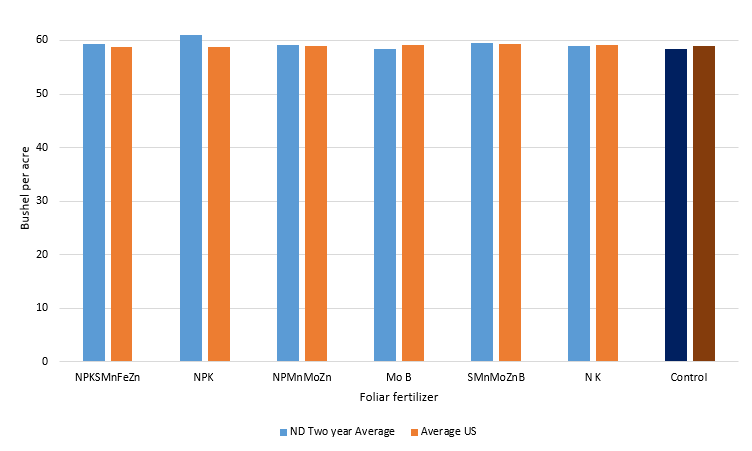Results of Foliar Fertilizer Application in Soybean
This page was adapted from the article, "Results of Foliar Fertilizer Application in Soybean," which appeared in Crop & Pest Report on July 21, 2022
Some producers may wonder if there are management practices that can be applied during the early reproductive growth to increase soybean yield. National soybean agronomists have put together a publication: The soybean growth cycle: important risks, management and misconceptions. Some producers are interested in knowing if foliar fertilizer may increase yield. However, it is not the yield increase that is important, it is the cost vs the benefit. Without a positive financial return on investment, additional inputs are not justified. Based on producers and agronomists requests, a large national research project was set up to evaluate six foliar fertilizer products to compare with an untreated control, in a randomized complete block design, with at least 4 replicates. This large project was conducted over a two year period with a total of 46 experiments. Data from North Dakota, South Dakota, and Minnesota were included in this project. The research sites were fields without known nutrient deficiencies, and they represented average soybean growing conditions. Products were applied at soybean R3 growth stage. Nutrients applied per acre for each product are listed in Table 1.
| Product | N | P | K | S | Mn | Fe | Mo | Zn | B | Other |
|---|---|---|---|---|---|---|---|---|---|---|
| 1 | 3.5 lb/a | 0.9 lb/a | 0.9 lb/a | 0.5 lb/a | 0.02 lb/a | 0.03 lb/a | - | 0.03 lb/a | - | - |
| 2 | 0.6 lb/a | 0.3 lb/a | 1.7 lb/a | - | - | - | - | - | - | - |
| 3 | 0.1 lb/a | 0.25 lb/a | - | - | 0.01 lb/a | - | 0.002 lb/a | 0.01 lb/a | Ca,Mg,B,Co,Cu | |
| 4 | - | - | - | - | - | - | 0.006 lb/a | - | 0.07 lb/a | - |
| 5 | 0.0 4lb/a | 0.08 lb/a | - | 0.003 lb/a | 0.08 lb/a | 0.06 lb/a | - | |||
| 6 | 1.9 lb/a | - | 1.9 lb/a | - | - | - | - | - | - | - |
| 7 Control | - | - | - | - | - | - | - | - | - | - |
The North Dakota results, as well as national results, (Figure 1), showed that foliar fertilization application in fields with no known nutrient deficiency did not increase soybean yield but decreased the profitability of soybean production (no increase in yield but a cost for application and cost of the fertilizer product). The conclusion: foliar fertilizer products, similar to those tested, are not recommended for use by North Dakota soybean producers in the absence of symptoms of nutrient deficiency. This research was conducted a part of the “Science for Success” project funded by the soybean checkoff. The full report Foliar Fertilizers Rarely Increase Yield in U.S. Soybean is available in pdf format. Further information on this trial, including individual site results, is available in the full publication at: https://doi.org/10.1002/agj2.20889.

